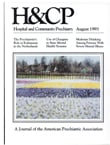A Randomized Trial of Psychiatric Day Treatment for Patients With Affective and Personality Disorders
Abstract
Objective: The outcome of a day treatment program for psychiatric outpatients with affective and pesonality disorders was evaluated. The program was dynamically oriented, intensive, group focused, and time limited (18 weeks). Methods: The prospective trial used a randomized treatment-versus-control (delayed-treatment) design to examine 1 7 outcome variables covering five areas: interpersonal functioning, symptomatology, selfesteem, life satisfaction, and defensive functioning. Those variables, plus individualized treatment objectives, were monitored before and after the treatment and control periods and at follow-up an average of eight months later. Results: Treated patients showed significantly better outcome than control patients for seven of the 1 7 outcome variables: social dysfunction, family dysfunction, interpersonal behavior, mood level, life satisfaction, self-esteem, and severity of disturbance associated with individual goals of treatment as rated by an independent assessor. The findings could not be accounted for by diagnosis or use of medication. Benefits were maintained over the followup period. The average treatment-versus-control effect size for all 17 variables was .71. Conclusions: The study supports the efficacy of an intensive day treatment program for patients who manifest significant difficulties associated with affective and personality disorders.
Access content
To read the fulltext, please use one of the options below to sign in or purchase access.- Personal login
- Institutional Login
- Sign in via OpenAthens
- Register for access
-
Please login/register if you wish to pair your device and check access availability.
Not a subscriber?
PsychiatryOnline subscription options offer access to the DSM-5 library, books, journals, CME, and patient resources. This all-in-one virtual library provides psychiatrists and mental health professionals with key resources for diagnosis, treatment, research, and professional development.
Need more help? PsychiatryOnline Customer Service may be reached by emailing [email protected] or by calling 800-368-5777 (in the U.S.) or 703-907-7322 (outside the U.S.).



